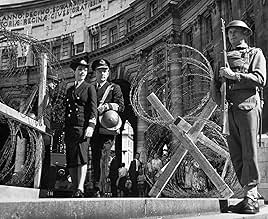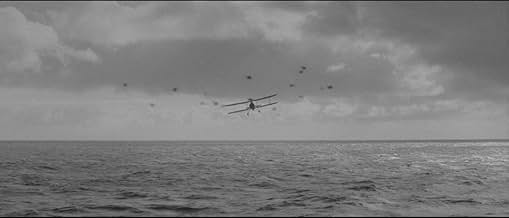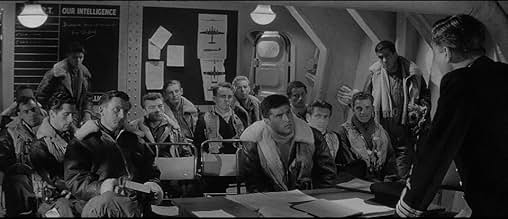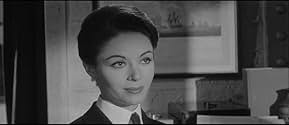AVALIAÇÃO DA IMDb
7,2/10
8,8 mil
SUA AVALIAÇÃO
Adicionar um enredo no seu idiomaThe World War II story of the Royal Navy's effort to defeat Nazi Germany's most powerful warship.The World War II story of the Royal Navy's effort to defeat Nazi Germany's most powerful warship.The World War II story of the Royal Navy's effort to defeat Nazi Germany's most powerful warship.
- Direção
- Roteiristas
- Artistas
- Prêmios
- 2 indicações no total
Carl Möhner
- Kapitän Ernst Lindemann
- (as Carl Mohner)
Jack Gwillim
- Commodore Wilfrid Patterson - HMS King George V
- (as Jack Gwillam)
Avaliações em destaque
This is a little known war time epic movie that should rank with the likes of "Patton". The story is about the grudge match that's spawned from sinking of battleship Hood by the German battleship Bismark. A full blown search for the German battleship by the British navy takes place to hunt down and sink the Bismark. Acting is first class, and although the special effects have something to be desired by today's standard, movie none the less conveys the tension and excitement of what probably was the greatest and the final naval conflict between battleships. In recent years Bob Ballard and the Oceanographic Institute rediscovered the sunken remains of the battleship Bismark which confirmed the ferocity of the fire power that was exchanged in this naval warfare. This movie gets mentioned by movie producers of today when they sight their seminal influence it had on some of their plot lines, which attests to its production value. The sub plot which unfolds between Kenneth Moore and Dana Wynter is also written superbly. A good war time semi documentary that's worth seeing.
I agree with the other reviewers who complained that Adm. Gunther Lutjens was portrayed as being a pro-Nazi when in actuality, he wasn't. In fact, Lutjens had protested against the dismissal of Jewish officers from the Navy and when Hitler came to visit the Bismarck 2 weeks before her departure, he gave Hitler the navy salute and not the Nazi salute.
Part of the problem with this movie is where 20th Century Fox obtained their material from. They used the material in C.S. Forrester's book "The Last Nine Days of the Bismarck". In that book Forrester had portrayed Lutjens as being pro-Nazi which had 20th Century Fox researched before making the movie, would have uncovered Forrester's mistake (intentional or not). A better book was Ludovic Kennedy's "Pursuit: The Chase and Sinking of the Battleship Bismarck," but I don't believe his book had come out at the time the movie was made. 20th Century Fox should have waited until it did than to base a true event on a possibly biased book.
Part of the problem with this movie is where 20th Century Fox obtained their material from. They used the material in C.S. Forrester's book "The Last Nine Days of the Bismarck". In that book Forrester had portrayed Lutjens as being pro-Nazi which had 20th Century Fox researched before making the movie, would have uncovered Forrester's mistake (intentional or not). A better book was Ludovic Kennedy's "Pursuit: The Chase and Sinking of the Battleship Bismarck," but I don't believe his book had come out at the time the movie was made. 20th Century Fox should have waited until it did than to base a true event on a possibly biased book.
and could just watch and enjoy the movie without analyzing it. That's what movies were originally for - entertainment and enjoyment. I don't know if the special effects were great for the time or not, but they looked enough like the real thing for me. Great naval battle scenes and the acting was perfect for the times portrayed of the 1940's and the real way that military people are mostly low key in planning discussions and carrying out their duties. All very believable scenes with the flavor of the way it really was even in portions that were added to entertain (when history takes a back seat to entertainment). Kenneth More showed his versatility in excelling in such a serious part and Dana Wynter very professional. I don't know why she didn't become a larger name here in the States with such pure beauty, grace and honest acting ability. By coincidence I just saw her in another movie In Love And War where she played a totally different type of part and nailed it great. Anyway, if you haven't seen Sink The Bismarck, then by all means give it a gander. It is time well spent for not only those who enjoy naval movies, but good drama films as well.
For starters, this picture was thankfully filmed in black and white. This is only appropriate for gray colored ships shooting it out in the North Atlantic. The performers were, for the most part, convincing. The movie got a little risky by using a fictional character (played by Kenneth More) for the lead role, and delving a bit into his personal life. But it didn't get out of hand. The movie takes just the right amount of time in developing and depicting the important events in the eight day life of the Bismarck. I got the feeling that I was actually there and watching these events take place. The movie is essentially accurate, based on accounts I have read in books; including one by the highest ranking German survivor. The depiction of the destruction of the British battle cruiser Hood was not exactly accurate, but I would rank that a minor point. Getting the ship used in the movie to blow up the same way the Hood would probably have been more trouble than it was worth. The bottom line is the ship was destroyed and only three crew members survived.
This movie is an excellent, no-nonsense portrayal of the short and dramatic life of the legendary German battleship Bismarck.
This movie is an excellent, no-nonsense portrayal of the short and dramatic life of the legendary German battleship Bismarck.
The German battleship Bismark was one of the finest warships ever built. She carried 8 15-inch guns and a powerful secondary battery and could make 30 knots. It wasn't one of the biggest or most powerful battleships ever built. The Japanese had the Yamato and Mushashi towards the end of the war, juggernauts with 18-inch cannons. There's a limit to gigantism of course, and in the case of battleships it had to do with whether they could fit physically through the Panama Canal, a concern the Japanese had long put behind them. So the Bismark wasn't the sort of sacred monster that sheer size would make her. But she LOOKED absolutely great. Sleek, well balanced, with her superstructure done the way an architect might have done it, not an engineer. She looked built for speed, and endurance too. For an example of the opposite trend, take a look at Rodney or Nelson. More powerfully armed, with 9 16-inch guns carried in three turrets, all set forward of the superstructure. Man, that is one ugly design. And, more than that, Bismarck's crew were highly trained and she was equipped with one of the world's best optical fire-control systems. It wasn't just luck that sank the Hood and damaged any smaller ships that go too close; it was good shooting. (Her shooting didn't fall off until that final bombardment.) Winston Churchill called her "a masterpiece of naval construction," although not in this movie. She kept large elements of the fleet pinned down at home simply by sitting in her protected port and being available.
I must have seen this movie a dozen times and each time I begin by wondering if I'll be able to sit through it again. (I've got some of the exchanges memorized.) I generally make it, though. It's too good in its own dated way to pass up.
The model work is not bad at all for its time. The reviewer who said this film called for black and white was correct. It looks cold and frightening on the North Atlantic. Almost everything would have been, or at least seemed, gray even if it had been shot in color. The peformances are up to professional standards. More is a different character here from his usual jocular one -- frosty, demanding, and no nonsense. Until finally, overcome with emotion, he breaks down in an understated scene. Dana Wynter, his assistant, spots him and discreetly leaves him alone. She's too beautiful to criticize as an actress. She radiates purity and anima and gently draws More out of his shell. Naismith is a familiar face, as are many of the others. And there is a running gag in this underground bunker where More is plotting the Bismarck's demise. Nobody knows what time it is or, if they know it's 9 o'clock, they don't know if its morning or evening. Even the Germans aboard the Bismarck are lent some humanity by the script writers. The cadets look like earnest fresh-faced kids. The Captain is a practical man, worried about his ship and his crew. Only Karel Stepanek, as Lutjens, belongs in another, much earlier movie, say one made in 1943. He is well out of the frame established in the rest of the film. Stricken with awe when he gets a birthday greeting from You-Know-Who. Some of the dialogue is made up, out of necessity. Who knows what went on on the Bismarck's bridge, especially during that last catastrophic shelling? Back in the bunker, Dana Wynter looks down at the wooden models on her chart where a dozen British warships surround the single Bismarck and pound her to pieces. "I don't feel like cheering," she says. Well, "War is all hell." Maybe that's why human beings seem to need another one every twenty years or so, to remind ourselves.
What a waste of great ships, and of good men, on both sides. And an argument could even be made that Bismarck's sister ship, the Tirpitz, played an even more important part in the war simply by staying put and tying down so many British ships that were needed elsewhere. Our side "wins," of course. Our side almost always wins when we're the side that's funding the movie. A lot of viewers will expectably feel relief when the threat represented by Bismarck is over, but they probably won't feel much like cheering.
I must have seen this movie a dozen times and each time I begin by wondering if I'll be able to sit through it again. (I've got some of the exchanges memorized.) I generally make it, though. It's too good in its own dated way to pass up.
The model work is not bad at all for its time. The reviewer who said this film called for black and white was correct. It looks cold and frightening on the North Atlantic. Almost everything would have been, or at least seemed, gray even if it had been shot in color. The peformances are up to professional standards. More is a different character here from his usual jocular one -- frosty, demanding, and no nonsense. Until finally, overcome with emotion, he breaks down in an understated scene. Dana Wynter, his assistant, spots him and discreetly leaves him alone. She's too beautiful to criticize as an actress. She radiates purity and anima and gently draws More out of his shell. Naismith is a familiar face, as are many of the others. And there is a running gag in this underground bunker where More is plotting the Bismarck's demise. Nobody knows what time it is or, if they know it's 9 o'clock, they don't know if its morning or evening. Even the Germans aboard the Bismarck are lent some humanity by the script writers. The cadets look like earnest fresh-faced kids. The Captain is a practical man, worried about his ship and his crew. Only Karel Stepanek, as Lutjens, belongs in another, much earlier movie, say one made in 1943. He is well out of the frame established in the rest of the film. Stricken with awe when he gets a birthday greeting from You-Know-Who. Some of the dialogue is made up, out of necessity. Who knows what went on on the Bismarck's bridge, especially during that last catastrophic shelling? Back in the bunker, Dana Wynter looks down at the wooden models on her chart where a dozen British warships surround the single Bismarck and pound her to pieces. "I don't feel like cheering," she says. Well, "War is all hell." Maybe that's why human beings seem to need another one every twenty years or so, to remind ourselves.
What a waste of great ships, and of good men, on both sides. And an argument could even be made that Bismarck's sister ship, the Tirpitz, played an even more important part in the war simply by staying put and tying down so many British ships that were needed elsewhere. Our side "wins," of course. Our side almost always wins when we're the side that's funding the movie. A lot of viewers will expectably feel relief when the threat represented by Bismarck is over, but they probably won't feel much like cheering.
Você sabia?
- CuriosidadesThe Bismarck's crew was made up of just over two thousand men. Following her sinking, only 114 survivors were rescued from the sea, 110 of them by HMS Dorsetshire and the Tribal-class destroyer HMS Maori. The rescue of survivors was called off by the captain of HMS Dorsetshire amid reports that a U-Boat may be in the area.
- Erros de gravaçãoThe characterization of Admiral Gunther Lütjens in this movie is wildly inaccurate. He is shown as a zealot, a fanatic, denying reality until the end. In fact, Lütjens was a thoughtful, even morose figure - some survivors claimed that his tendency for fatalism damaged their morale. Absurdly, on screen the Admiral tells his men to "remember you are Nazis!" Lütjens was not a Nazi (very much the opposite, to the extent that he famously refused to perform the Nazi salute for Hitler before the Bismarck set sail), nor were the vast majority of his officers and crew.
- Citações
[to his assistant Anne Davis, after the battle]
Captain Jonathan Shepard: Take a message: "Request pleasure of the company of Second Officer Anne Davis at dinner."
- Cenas durante ou pós-créditosOpening credits prologue: LONDON MAY 1941
- ConexõesEdited from A Raposa do Mar (1957)
Principais escolhas
Faça login para avaliar e ver a lista de recomendações personalizadas
- How long is Sink the Bismarck!?Fornecido pela Alexa
Detalhes
- Data de lançamento
- Países de origem
- Idiomas
- Também conhecido como
- ¡Hundan al Bismarck!
- Locações de filme
- Empresa de produção
- Consulte mais créditos da empresa na IMDbPro
Bilheteria
- Orçamento
- US$ 1.330.000 (estimativa)
- Tempo de duração1 hora 37 minutos
- Cor
- Mixagem de som
- Proporção
- 2.20 : 1
- 2.35 : 1
Contribua para esta página
Sugerir uma alteração ou adicionar conteúdo ausente

Principal brecha
By what name was Afundem o Bismarck (1960) officially released in India in English?
Responda



































